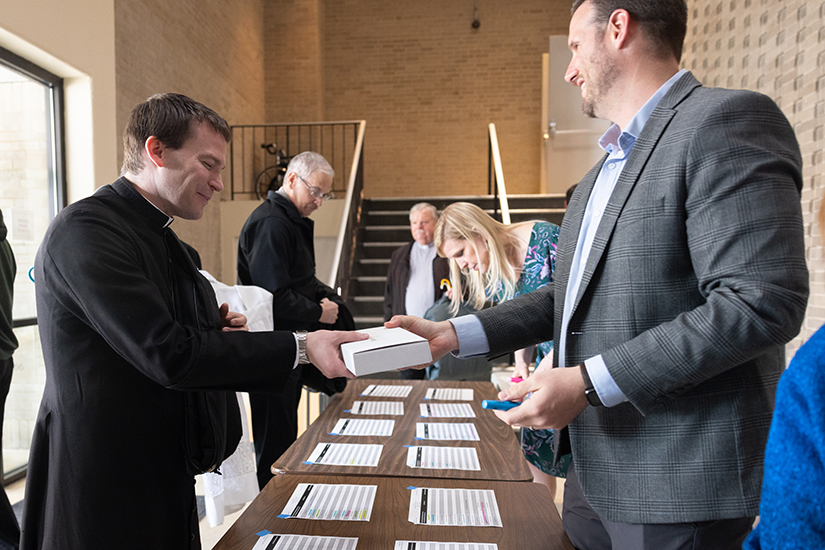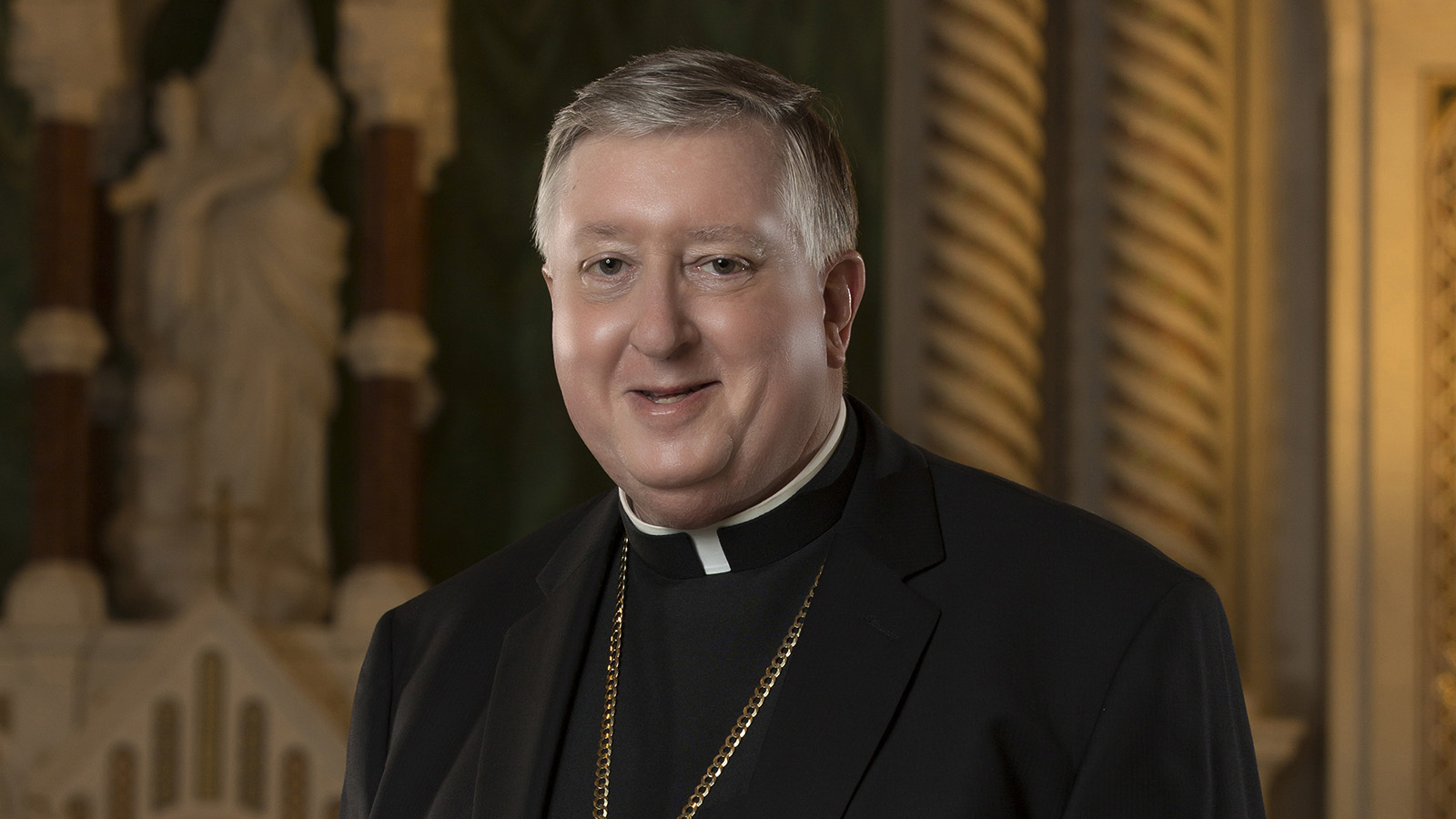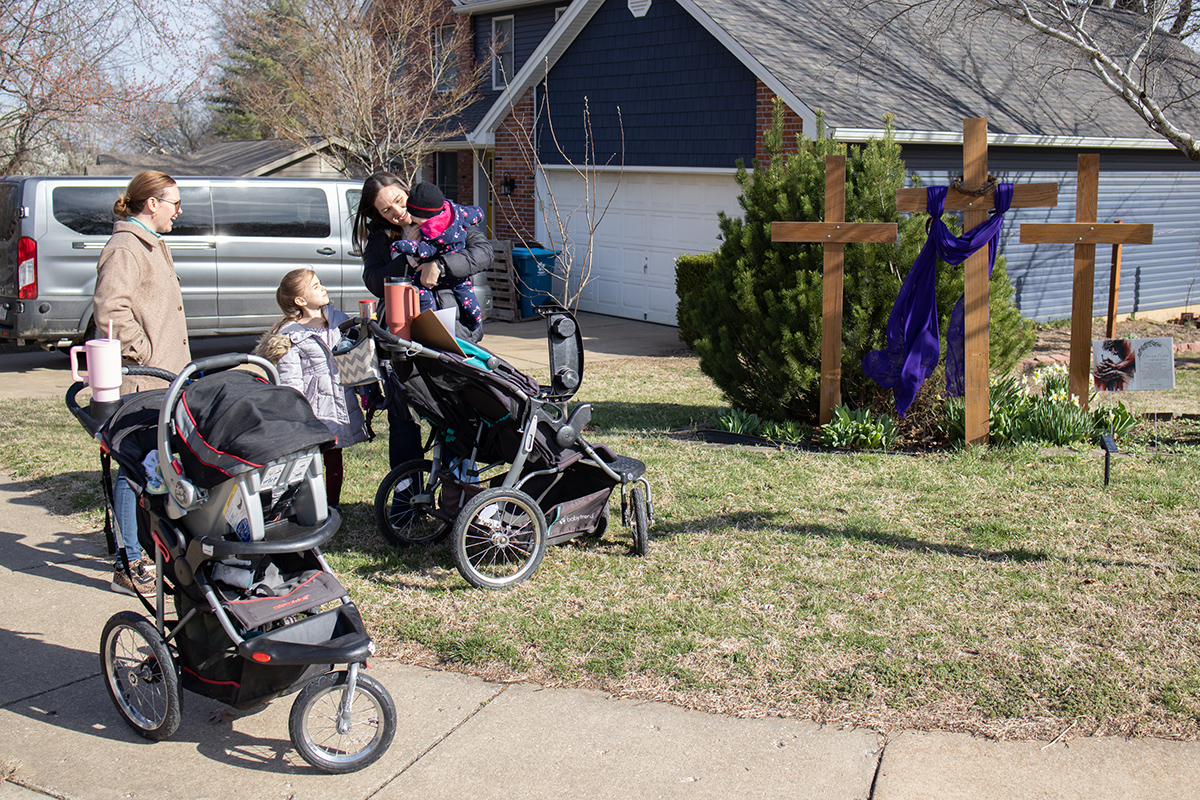From ordinary to sacred

How 45 liters of retail olive oil becomes the matter used for sacraments
At the annual Chrism Mass at the Cathedral Basilica of Saint Louis on Holy Thursday morning, Archbishop Mitchell T. Rozanski blessed the three holy oils that will be used throughout the year: the oil of the sick, the oil of catechumens and the sacred chrism.
How does ordinary olive oil from a store shelf become the matter of sacraments used around the archdiocese?
Step One: Acquiring the olive oil
Mary Ann Fox, events manager at the Cathedral Basilica of Saint Louis, bought 15 3-liter cans of Lakonia-brand extra virgin olive oil from Restaurant Depot. Buying it in bulk there is a good deal, said Tom Fasl, the cathedral’s finance manager. And besides — the Lord can work with humble materials.
The oil of the sick and oil of catechumens are pure olive oil, but sacred chrism needs another ingredient: balsam, an aromatic perfume. The archdiocese sources its balsam, in bottles labeled “Laudate chrism essence,” from the Holy Rood Guild, the liturgical shop of the Trappist monks at St. Joseph’s Abbey in Spencer, Massachusetts. (No, balsam isn’t sold at Restaurant Depot.)

Step Two: From cans to silver vessels
At about 8 a.m. Thursday morning, two hours before Mass began, cathedral employees brought the oil into a side chapel in the cathedral, where the three silver oil vessels awaited. These vessels are engraved with the name of their respective oil and are used only for this purpose each year. They poured five cans — 15 liters — of oil into each one. The balsam was poured into two smaller, golden pitchers for Archbishop Rozanski to mix with the oil for the sacred chrism.

Step Three: The blessing and consecration
Following the homily and the priests’ renewal of priestly service, Deacons James Bohnert, Charles Durban, Keith Henderson, Kirk Lackas, Dale Follen and Jacob Braun — two deacons for each of the three vessels — carried the oil-filled vessels to the sanctuary and presented them to Archbishop Rozanski.
Archbishop Rozanksi blessed the oils of the sick and the catechumens, which are used in the sacraments of the anointing of the sick and for those preparing to be baptized, respectively.
To make the sacred chrism, he poured the balsam into the third vessel, mixed it with a large spoon, then breathed into the vessel.
Breathing into the vessel “recalls the Spirit of God ‘moving over the face of the waters’ at creation (Genesis 1:12) and Jesus’ resurrection appearance to the disciples in which ‘He breathed on them and said to them, ‘Receive the Holy Spirit” (Jn 20:22),” according to the USCCB.
Chrism is used to anoint the faithful in baptism and confirmation and to anoint priests and bishops at ordination, used as a sign of spiritual strengthening, enabling us to live out the call to follow Jesus. Chrism is also used when dedicating a church.
Once the oils are blessed and chrism is consecrated, they are no longer ordinary oil; they are instruments of God, used to bring His grace to His people through the sacraments. Whenever the holy oils are used, the ministry of the bishop who consecrated them is symbolically present.
(Text of the prayers of blessing and consecration are at https://stlreview.com/3zElLwM)

Step four: Dividing the oils for every parish
The same deacons carried the now-holy oils through a side door of the cathedral to Boland Hall, where about 20 volunteers divided it up to be distributed to parishes. The volunteers, led by Office of Sacred Worship coordinator Amy Buehrle and fueled by coffee and treats from nearby Vincent Van Doughnut, started working around 9 a.m., folding cardboard boxes and labeling each 3-oz. glass bottle with the kind of holy oil it will contain.
A table of four volunteers took on each of the three silver vessels. Two poured oil from the spouts into the small bottles, then the others screwed the caps on. Jane Guenther, director of the archdiocesan Catholic Renewal Center, always stations herself at the oil of the sick. Although that particular vessel’s spouts notoriously pour the slowest, she doesn’t mind; it just gives her extra time to pray for each one of the sick and suffering who will be anointed by the oil, she said.
Other volunteers walked around, filling the boxes with one bottle of each oil to make 260 complete sets.
They passed them off to Kathy Fotouhi, a parishioner at St. Peter in Kirkwood, who folded the boxes closed and placed them on a cart. She’s helped with the oil operation for the past 10 years. Her husband came into the Church about 30 years ago, and she gets emotional thinking about the current candidates and catechumens who will be anointed with the holy oils she packages, she said.
“It’s really amazing to think about all the people who will be touched by these oils all throughout the archdiocese,” she said.

Step five: Into the hands of the priests
After the Chrism Mass, priests went to Boland Hall to pick up boxes of holy oils to bring back to their respective parishes. Some requested extra bottles of certain oils; for instance, a priest assigned to a hospital chaplaincy needs extra oil of the sick, and the bishops need extra sacred chrism for the many confirmations they celebrate.

Buehrle keeps track of it all in an extensive, alphabetical spreadsheet that she’s been working on since January. If a priest runs out of one of the oils during the year, the cathedral has extra on hand to replenish it.
That evening, many of the priests begin the Holy Thursday Mass of the Lord’s Supper with a simple rite for the parish to receive the holy oils and explain their meaning. The oils are often stored in a clear cabinet, called an ambry, in a visible place in the church.
Step six: Proper disposal
Anything that is blessed or consecrated must be disposed of properly. To make room for the new set of oils, any oil that parishes have left from the previous year is poured into the earth or burned in a fire, such as the Easter Vigil fire.
Back in Boland Hall, that includes anything that touched the holy oils during the bottling process. No paper towel, used to blot a drop of oil from the side of a bottle, is carelessly left in the trash; they’re gathered up and burned after the morning’s work is finished.
Because in this most sacred of days, even the most ordinary things are made holy.
At the annual Chrism Mass at the Cathedral Basilica of Saint Louis on Holy Thursday morning, Archbishop Mitchell T. Rozanski blessed the three holy oils that will be used throughout … From ordinary to sacred
Subscribe to Read All St. Louis Review Stories
All readers receive 5 stories to read free per month. After that, readers will need to be logged in.
If you are currently receive the St. Louis Review at your home or office, please send your name and address (and subscriber id if you know it) to subscriptions@stlouisreview.com to get your login information.
If you are not currently a subscriber to the St. Louis Review, please contact subscriptions@stlouisreview.com for information on how to subscribe.



